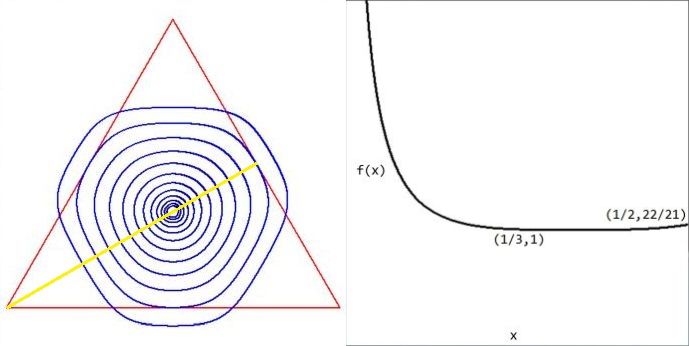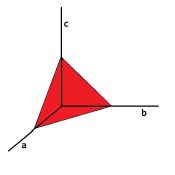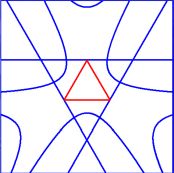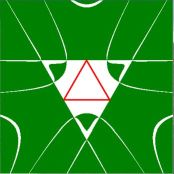



Step 1. Transformation.
The three dimensional problem can be re-formulated as a two dimensional problem by introducing,
quite like here , exactly the same triangle coordinates:
$$
\left[ \begin{array}{c} a \\ b \\ c \end{array} \right] =
\left[ \begin{array}{c} 3 \\ 0 \\ 0 \end{array} \right] +
\left[ \begin{array}{c} -3 \\ 3 \\ 0 \end{array} \right] x +
\left[ \begin{array}{c} -3 \\ 0 \\ 3 \end{array} \right] y
$$
Then the inequality $\;\frac{2}{(a+b)(4-ab)}+\frac{2}{(b+c)(4-bc)}+\frac{2}{(a+c)(4-ac)}\ge 1\;$ does not so much "simplify",
but anyway becomes an inequality in two
variables. And the equation $\;a + b + c = 3\;$ corresponds with a normed 2-D triangle, with vertices $(0,0),(1,0),(0,1)$ .
Step 2. Visualization.
The insides and outsides of both can easily be visualized, as has been done in the above picture on the right
(seen in the plane of the triangle, with a transformation rectangular $(x,y) \rightarrow$ equilateral) :
$\color{red}{red}$ for
the edges of $\;a + b + c = 3\;$ and $\color{green}{green}$ for $\;\frac{2}{(a+b)(4-ab)}+\frac{2}{(b+c)(4-bc)}+\frac{2}{(a+c)(4-ac)} < 1\;$
and simply white for $\;\frac{2}{(a+b)(4-ab)}+\frac{2}{(b+c)(4-bc)}+\frac{2}{(a+c)(4-ac)} > 1\;$ .
(With a smooth function - this one is not - the isolines would look a lot "neater".)
It is seen in the same picture that the vertices of the triangle could well have been put on the curve
$\frac{2}{(a+b)(4-ab)}+\frac{2}{(b+c)(4-bc)}+\frac{2}{(a+c)(4-ac)} = 1$ .
However, this would require that $x=0$ and/or $y=0$ , which is excluded by $\;b=3x,c=3y$ both $> 0$ .
For the rest the triangle is seen to be on the outside of that curve , i.e. in the white area, thus establishing,
at first sight, the given inequality.
Step 3. Triangle edges.
Due to the denominators which can be zero,
singularities - $\color{blue}{blue}$ lines in the middle picture - are an issue with this problem.
It is seen that the vertices of the triangle are located at singular spots. Without the additional requirement
$a,b,c > 0$ that would have been problematic.
Indeed. Define the function:
$$
f(a,b,c) = \frac{2}{(a+b)(4-ab)}+\frac{2}{(b+c)(4-bc)}+\frac{2}{(a+c)(4-ac)}
$$
And specify for the triangle coordinates along one of the edges, say $c=3y=0$ , then:
$$
f(a=3-3x,b=3x,c=0) = \frac{2}{3[4-9(1-x)x]} + \frac{2}{12x} + \frac{2}{12(1-x)} \\ = \frac{2/27}{(x-1/2)^2+7/36} + \frac{1/6}{1/4-(x-1/2)^2}
$$
As expected, singularities are found for $x=0,1$ . The minimum function value along a triangle edge equals $22/21 > 1$ and is found for $x=1/2$ .
To be certain, by differentiation we find:
$$
f'(x) = -\frac{2(2x-1)}{27\left[(x-1/2)^2+7/36\right]^2} + \frac{2x-1}{6\left[1/4-(x-1/2)^2\right]^2} = 0
$$
From which it is immediately clear that $x=1/2\;$ is a solution. And in the neighborhood $x\approx 1/2$ :
$f'(x) \approx (-2/27(36/7)^2+4^2/6)(2x-1) = 104/147(2x-1)$ which is $< 0$ for $x < 1/2$ and $> 0$ for $x > 1/2$ ,
hence a minimum.
Step 4. Triangle inside.
There is not a whole bunch of points inside the triangle where $f(a,b,c) = 1$,
because otherwise we would have seen them as green pixels. But the fact that
they are not seen is not a proof that they do not exist. So we still have to
establish, analytically, that $f(a,b,c)$ assumes no smaller values than $1$ inside the triangle.
Luck is on our path. In one of the
comments accompanying the question
Why does Group Theory not come in here? a key reference is mentioned:
Update. As a reply to the comments about whether there could perhaps exist
a minimum at a lower level than $1$ , here comes a contour plot of $\;f(a,b,c)\;$
values in the plane of the triangle at levels $\; 1 < (2^k*10+2)/(2^k*10+1) \quad , \quad k=0 , \cdots , 11$ .
Showing a rather "flat" function behaviour, though definitely descending
towards the middle of the triangle : the perimeters of the contours are invariably diminishing with increasing values of $\;k\;$.

Let's specify $f(a,b,c)$ for $y=x\;$ i.e. $\;a=3(1-2x) , b=3x , c=3x$ . This is the yellow line in the contour plot on the left. Then we have: $$ f(x) := f(3(1-2x),3x,3x) = \frac{4}{3(1-x)(4-9x+18x^2)}+\frac{1}{3x(4-9x^2)} $$ The graph of this function is seen on the right. As expected, there is a positive singularity at $x=0$ . Then the function decreases uniformly until it reaches its minimum $f(1/3)=1$ at the center of the triangle. After that it raises a little bit until that local maximum $f(1/2)=22/21$ in the middle of an edge. That $f(1/3)=1$ is indeed a minimum can be verified by calculating $f'(1/3) = 0$ .